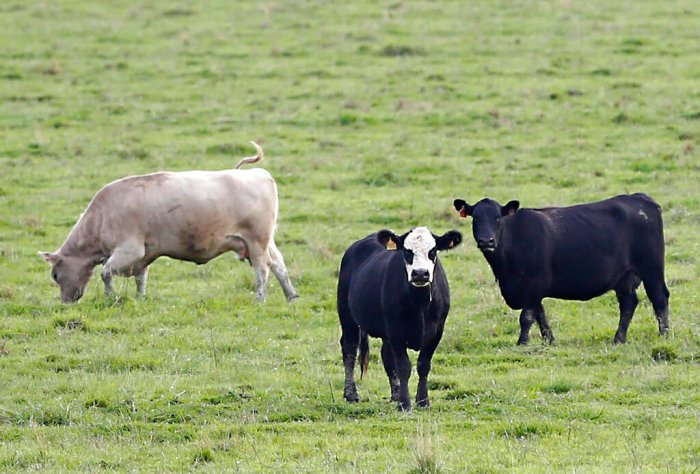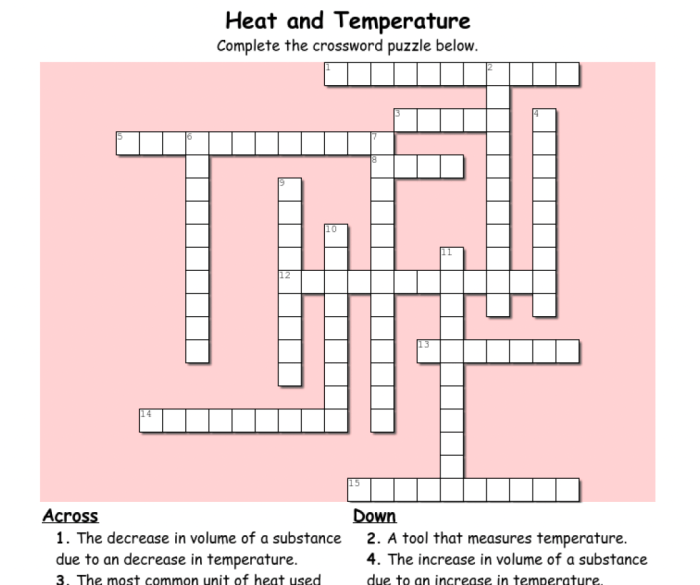Welcome to the enigmatic realm of hot and dry crossword clues, where arid landscapes ignite curiosity and challenge the limits of knowledge. Prepare to embark on a journey through the heart of deserts, unraveling the secrets of their unforgiving conditions and the remarkable adaptations that sustain life amidst the relentless heat and scarcity.
From towering sand dunes to parched riverbeds, deserts paint a vivid tapestry of extremes. Their unique ecosystems, shaped by relentless sun and scant rainfall, foster a fascinating array of plant and animal life. Discover how these resilient species endure the harsh conditions, conserving precious water and tolerating scorching temperatures.
Desert Characteristics

Deserts, with their scorching temperatures and parched landscapes, stand as some of the most inhospitable environments on Earth. These regions receive scant rainfall, typically less than 25 centimeters annually, and endure extreme temperature fluctuations. Such arid conditions profoundly shape the desert’s flora, fauna, and overall ecosystem.
The relentless heat and dryness of deserts impose severe constraints on life. Plants have adapted to these conditions by developing deep root systems that tap into subterranean water sources. Succulents, with their fleshy stems and leaves, store moisture to withstand prolonged droughts.
Animals, too, have evolved unique adaptations to survive in this harsh environment. Many species are nocturnal, emerging from their shelters under the cover of darkness to avoid the scorching heat of the day.
Desert Biomes
Deserts encompass a diverse range of biomes, each with its characteristic plant and animal communities. The Sahara Desert, the largest hot desert in the world, is home to a variety of desert-adapted species, including the Saharan cheetah, Barbary sheep, and Fennec fox.
If you’re stuck on a crossword clue that mentions something hot and dry, don’t sweat it! Check out Saxon Math Homeschool 6 5 for some helpful tips and strategies. With a little bit of practice, you’ll be solving crossword puzzles like a pro in no time!
The Gobi Desert, a vast expanse in Central Asia, supports a rich array of plant life, including drought-tolerant shrubs and grasses. The Atacama Desert in South America, renowned for its extreme aridity, is home to unique and resilient organisms, such as the Atacama giant cactus and the Andean flamingo.
Desert Flora and Fauna

Desert ecosystems, characterized by extreme temperatures and limited water availability, foster unique adaptations among its inhabitants. Both flora and fauna have evolved remarkable strategies to survive and thrive in these harsh conditions.
Adaptations of Desert Plants
Desert plants exhibit several adaptations to conserve water and tolerate high temperatures. Their leaves are often small, thick, or covered with waxy cuticles to reduce water loss through transpiration. Some plants have developed deep root systems to tap into underground water sources.
Others have succulent stems or leaves that store water for extended periods.
Adaptations of Desert Animals
Desert animals have also adapted to the extreme conditions. Many are nocturnal, avoiding the intense daytime heat. They may have long legs or large feet to distribute their weight over the soft sand. Some animals burrow underground to escape the heat and access moisture.
Others have evolved specialized cooling mechanisms, such as panting or sweating, to regulate their body temperature.
Unique Desert Species
The desert environment supports a diverse range of unique species. Examples include the saguaro cactus, a giant succulent that can reach heights of up to 40 feet; the camel, known for its ability to store water in its hump; and the fennec fox, with its large ears that dissipate heat.
Desert Landforms

Deserts exhibit a fascinating array of landforms, each shaped by the relentless forces of wind and erosion. These geological marvels range from towering sand dunes to vast, flat plains, showcasing the immense power of nature’s sculpting tools.
Sand Dunes
Sand dunes are iconic desert features, formed by the accumulation and movement of windblown sand. As wind picks up sand grains, it transports them across the desert surface. When the wind’s velocity decreases, the sand grains settle, forming mounds or ridges known as dunes.
Over time, the wind continuously reshapes these dunes, creating intricate patterns and varying heights.
Mesas
Mesas are flat-topped, isolated hills or mountains with steep sides. They are formed when layers of rock are eroded by wind and water, leaving behind a resistant caprock that protects the top of the mesa. The caprock is often made of harder materials, such as sandstone or limestone, which withstand erosion better than the softer layers beneath.
Other Desert Landforms
Beyond sand dunes and mesas, deserts also feature a variety of other landforms, including:
- Playas:Dry, flat lake beds that form when water evaporates from shallow basins.
- Buttes:Isolated, hill-like landforms with steep sides and a relatively flat top.
- Canyons:Deep, narrow gorges carved by rivers or streams.
- Arches:Natural rock formations with a hole or opening created by erosion.
These landforms contribute to the unique and awe-inspiring landscapes of deserts, showcasing the power of geological processes over time.
Human Impact on Deserts

Deserts are not just empty landscapes; they are dynamic ecosystems that support diverse flora and fauna. However, human activities can have significant impacts on desert ecosystems. Understanding these impacts and adopting sustainable practices are crucial for preserving the delicate balance of desert environments.
Challenges of Living in Deserts
- Water scarcity:Deserts are arid regions with limited water resources. Access to clean water is a major challenge for human settlements in these areas.
- Extreme temperatures:Deserts experience extreme temperature fluctuations, with scorching days and freezing nights. This can pose health risks and challenges for daily life.
- Lack of infrastructure:Desert regions often lack basic infrastructure, such as roads, electricity, and healthcare facilities. This can hinder development and access to essential services.
Opportunities of Living in Deserts
- Tourism:Deserts offer unique and awe-inspiring landscapes that attract tourists from around the world. This can create economic opportunities for local communities.
- Renewable energy:Deserts have abundant sunshine and wind, making them ideal for solar and wind energy projects. These renewable sources can provide sustainable energy solutions.
li> Mining:Deserts are rich in mineral resources, such as copper, gold, and uranium. Mining can provide employment and economic benefits, but it must be managed responsibly to minimize environmental impacts.
Human Activities and Desert Ecosystems
Human activities can disrupt the delicate balance of desert ecosystems. These include:
- Overgrazing:Excessive grazing by livestock can damage vegetation and deplete water resources.
- Deforestation:Clearing desert vegetation for agriculture or development can lead to soil erosion and loss of biodiversity.
- Pollution:Industrial activities, mining, and tourism can release pollutants into the desert environment, harming wildlife and human health.
- Climate change:Rising temperatures and changes in precipitation patterns due to climate change are impacting desert ecosystems, leading to shifts in plant and animal distributions.
Sustainable Practices for Desert Conservation
To preserve desert ecosystems, sustainable practices are essential. These include:
- Water conservation:Implementing water-efficient technologies, such as drip irrigation, and promoting responsible water use.
- Sustainable grazing:Managing grazing practices to prevent overgrazing and protect vegetation.
- Responsible mining:Adopting environmentally friendly mining techniques to minimize impacts on desert ecosystems.
- Renewable energy development:Harnessing solar and wind energy to reduce reliance on fossil fuels and minimize carbon emissions.
- Ecotourism:Promoting responsible tourism practices that minimize environmental impacts and support local communities.
Cultural Significance of Deserts: Hot And Dry Crossword Clue

Deserts, with their vast and enigmatic landscapes, have captivated human imagination for centuries. They have served as both a source of inspiration and a backdrop for countless cultural expressions.
Literature, Art, and Music
Deserts have played a prominent role in literature, inspiring works by renowned authors such as Antoine de Saint-Exupéry, Lawrence of Arabia, and John Steinbeck. Their desolate landscapes, harsh conditions, and sense of isolation provide a rich canvas for exploring themes of survival, resilience, and the human spirit.
In art, deserts have been depicted by masters like Salvador Dalí and Georgia O’Keeffe, who captured their surreal beauty and ethereal qualities. Musical compositions, from classical to contemporary, have also been inspired by the desert’s unique soundscape, featuring instruments like the didgeridoo and the Arabian oud.
Historical and Mythological Influence, Hot and dry crossword clue
Deserts have significantly influenced human history and mythology. Ancient civilizations like the Egyptians and the Mesopotamians flourished in desert regions, relying on their oases and water sources. Deserts have also been the setting for pivotal battles, trade routes, and religious pilgrimages.
In mythology, deserts often represent a place of transformation, testing, and spiritual enlightenment. They are associated with deities like Set, the Egyptian god of chaos, and Coyote, the Native American trickster figure.
Cultural Traditions
Deserts have fostered unique cultural traditions among the indigenous communities that inhabit them. These traditions include:
Bedouin Hospitality
The Bedouin people of the Arabian Desert are renowned for their warm hospitality, offering shelter and food to travelers in need.
Desert Festivals
Many cultures celebrate desert-themed festivals, featuring traditional music, dance, and competitions. Examples include the Jaisalmer Desert Festival in India and the Abu Dhabi Desert Challenge.
Desert Cuisine
Desert cuisine often reflects the scarcity of resources, featuring dishes that are simple, nutritious, and easily preserved. Examples include dates, camel milk, and flatbreads.
User Queries
What are the defining characteristics of a hot and dry environment?
Hot and dry environments, typically found in deserts, are characterized by high temperatures, low rainfall, and limited water availability.
How do plants and animals adapt to survive in hot and dry conditions?
Plants develop deep root systems to access underground water, while animals exhibit physiological adaptations such as water conservation mechanisms and heat tolerance.
What are some iconic landforms associated with hot and dry environments?
Sand dunes, mesas, and canyons are common landforms shaped by wind and erosion in hot and dry environments.
